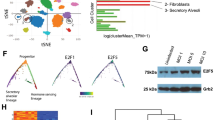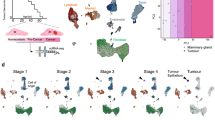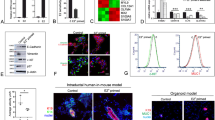Abstract
LMO4, a member of the LIM-only family of zinc-finger proteins, is overexpressed in a significant proportion of breast carcinomas and acts as a negative regulator of mammary epithelial differentiation. To delineate cell types within the developing mouse mammary gland that express Lmo4, we analysed different stages of mammopoiesis by immunohistochemistry. Lmo4 was found to be highly expressed in the proliferating cap cells of the terminal end bud and in the ductal and alveolar luminal cells of the mature mammary gland but was negligible or low in myoepithelial cells. To assess the physiological role of Lmo4 in the mammary gland, we generated conditionally targeted mice lacking Lmo4 in the mammary epithelium during pregnancy. Acute loss of Lmo4 in late pregnancy impaired lobuloalveolar development, accompanied by a two-fold reduction in the percentage of BrdU-positive cells. In contrast, germline loss of Lmo4 did not alter lobuloalveolar development arising from transplanted mammary anlagen, implying the existence of a compensatory mechanism in these knockout mice. Thus, the use of a conditional targeting strategy has revealed that Lmo4 is required for proper development of the mammary gland during pregnancy and indicated that Lmo4 acts as a positive regulator of alveolar epithelial proliferation.
This is a preview of subscription content, access via your institution
Access options
Subscribe to this journal
Receive 50 print issues and online access
$259.00 per year
only $5.18 per issue
Buy this article
- Purchase on SpringerLink
- Instant access to full article PDF
Prices may be subject to local taxes which are calculated during checkout





Similar content being viewed by others
References
Anderson E and Clarke RB . (2004). J. Mamm. Gland Biol. Neoplasia, 9, 3–13.
Andrechek ER, Hardy WR, Laing MA and Muller WJ . (2004). Proc. Natl. Acad. Sci. USA, 101, 4984–4989.
Bach I . (2000). Mech. Dev., 91, 5–17.
Bulchand S, Subramanian L and Tole S . (2003). Dev. Dyn., 226, 460–469.
Daniel CW and Silberstein GB . (1987). The Mammary Gland. Neville MC and Daniel CW (eds). Plenum Press: New York, pp. 3–36.
Dawid IB, Breen JJ and Toyama R . (1998). Trends Genet., 14, 156–162.
Fisch P, Boehm T, Lavenir I, Larson T, Arno J, Forster A and Rabbitts TH . (1992). Oncogene, 7, 2389–2397.
Grutz G, Forster A and Rabbitts TH . (1998). Oncogene, 17, 2799–2803.
Hacein-Bey-Abina S, Von Kalle C, Schmidt M, McCormack MP, Wulffraat N, Leboulch P, Lim A, Osborne CS, Pawliuk R, Morillon E, Sorensen R, Forster A, Fraser P, Cohen JI, de Saint Basile G, Alexander I, Wintergerst U, Frebourg T, Aurias A, Stoppa-Lyonnet D, Romana S, Radford-Weiss I, Gross F, Valensi F, Delabesse E, Macintyre E, Sigaux F, Soulier J, Leiva LE, Wissler M, Prinz C, Rabbitts TH, Le Deist F, Fischer A and Cavazzana-Calvo M . (2003). Science, 302, 415–419.
Hahm K, Sum EY, Fujiwara Y, Lindeman GJ, Visvader JE and Orkin SH . (2004). Mol. Cell. Biol., 24, 2074–2082.
Hennighausen L and Robinson GW . (1998). Genes Dev., 12, 449–455.
Hermanson O, Sugihara TM and Andersen B . (1999). Cell. Mol. Biol. (Noisy-le-grand), 45, 677–686.
Hovey RC, Trott JF and Vonderhaar BK . (2002). J. Mamm. Gland Biol. Neoplasia, 7, 17–38.
Kenney NJ, Smith GH, Lawrence E, Barrett JC and Salomon DS . (2001). J. Biomed. Biotechnol., 1, 133–143.
Kenny DA, Jurata LW, Saga Y and Gill GN . (1998). Proc. Natl. Acad. Sci. USA, 95, 11257–11262.
Kudryavtseva EI, Sugihara TM, Wang N, Lasso RJ, Gudnason JF, Lipkin SM and Andersen B . (2003). Dev. Dyn., 226, 604–617.
Larson RC, Lavenir I, Larson TA, Baer R, Warren AJ, Wadman I, Nottage K and Rabbitts TH . (1996). EMBO J., 15, 1021–1027.
Li L, Cleary S, Mandarano MA, Long W, Birchmeier C and Jones FE . (2002). Oncogene, 21, 4900–4907.
Manetopoulos C, Hansson A, Karlsson J, Jonsson JI and Axelson H . (2003). Biochem. Biophys. Res. Commun., 307, 891–899.
McGuire EA, Rintoul CE, Sclar GM and Korsmeyer SJ . (1992). Mol. Cell. Biol., 12, 4186–4196.
Medina D and Smith GH . (1990). Protoplasma, 159, 77–84.
Mizunuma H, Miyazawa J, Sanada K and Imai K . (2003). Br. J. Cancer, 88, 1543–1548.
Neale GA, Rehg JE and Goorha RM . (1997). Leukemia, 11 (Suppl 3), 289–290.
Nicholson SE, Willson TA, Farley A, Starr R, Zhang JG, Baca M, Alexander WS, Metcalf D, Hilton DJ and Nicola NA . (1999). EMBO J., 18, 375–385.
Rabbitts TH . (1998). Genes Dev., 12, 2651–2657.
Racevskis J, Dill A, Sparano JA and Ruan H . (1999). Biochim. Biophys. Acta., 1445, 148–153.
Robinson GW, Accili D and Hennighausen L . (2000). Methods in Mammary Gland Biology and Breast Cancer Research. Ip MM and Asch BB (eds). Kluwer Academic/Plenum Publishers: New York, pp. 307–316.
Russo J, Ao X, Grill C and Russo IH . (1999). Breast Cancer Res. Treat., 53, 217–227.
Sage J, Miller AL, Perez-Mancera PA, Wysocki JM and Jacks T . (2003). Nature, 424, 223–228.
Silberstein GB . (2001). Microsc. Res. Techn., 52, 155–162.
Sugihara TM, Bach I, Kioussi C, Rosenfeld MG and Andersen B . (1998). Proc. Natl. Acad. Sci. USA, 95, 15418–15423.
Sum EY, O’Reilly LA, Jonas N, Lindeman GJ and Visvader JE . (2005). J. Histochem. Cytochem., 53, 475–486.
Sum EY, Peng B, Yu X, Chen J, Byrne J, Lindeman GJ and Visvader JE . (2002). J. Biol. Chem., 277, 7849–7856.
Tse E, Smith AJ, Hunt S, Lavenir I, Forster A, Warren AJ, Grutz G, Foroni L, Carlton MB, Colledge WH, Boehm T and Rabbitts TH . (2004). Mol. Cell. Biol., 24, 2063–2073.
Visvader JE and Lindeman GJ . (2003). Int. J. Biochem. Cell. Biol., 35, 1034–1051.
Visvader JE, Venter D, Hahm K, Santamaria M, Sum EYM, O’Reilly L, White D, Williams R, Armes J and Lindeman GJ . (2001). Proc. Natl. Acad. Sci. USA, 98, 14452–14457.
Vooijs M, Jonkers J and Berns A . (2001). EMBO Rep., 2, 292–297.
Vu D, Marin P, Walzer C, Cathieni MM, Bianchi EN, Saidji F, Leuba G, Bouras C and Savioz A . (2003). Brain Res. Mol. Brain Res., 115, 93–103.
Wadman IA, Osada H, Grutz GG, Agulnick AD, Westphal H, Forster A and Rabbitts TH . (1997). EMBO J., 16, 3145–3157.
Wagner KU, Wall RJ, St-Onge L, Gruss P, Wynshaw-Boris A, Garrett L, Li M, Furth PA and Hennighausen L . (1997). Nucleic Acids Res., 25, 4323–4330.
Wang N, Kudryavtseva E, Ch’en IL, McCormick J, Sugihara TM, Ruiz R and Andersen B . (2004). Oncogene, 23, 1507–1513.
Warren AJ, Colledge WH, Carlton MB, Evans MJ, Smith AJ and Rabbitts TH . (1994). Cell, 78, 45–57.
Williams JM and Daniel CW . (1983). Dev. Biol., 91, 274–290.
Yamada Y, Pannell R, Forster A and Rabbitts TH . (2000). Proc. Natl. Acad. Sci. USA, 91, 320–324.
Yamada Y, Warren AJ, Dobson C, Forster A, Pannell R and Rabbitts TH . (1998). Proc. Natl. Acad. Sci. USA, 95, 3890–3895.
Acknowledgements
We are grateful to S Orkin for his generous gift of floxed Lmo4 mice. We wish to thank F Vaillant and G Robinson for invaluable advice and S Mihajlovic for histology. This work was supported by the Victorian Breast Cancer Research Consortium Inc. and the National Health and Medical Research Council (Australia).
Author information
Authors and Affiliations
Corresponding author
Rights and permissions
About this article
Cite this article
Sum, E., Shackleton, M., Hahm, K. et al. Loss of the LIM domain protein Lmo4 in the mammary gland during pregnancy impedes lobuloalveolar development. Oncogene 24, 4820–4828 (2005). https://doi.org/10.1038/sj.onc.1208638
Received:
Revised:
Accepted:
Published:
Issue date:
DOI: https://doi.org/10.1038/sj.onc.1208638
Keywords
This article is cited by
-
The dynamics of murine mammary stem/progenitor cells
Frontiers in Biology (2014)
-
Phenotypic and functional characterisation of the luminal cell hierarchy of the mammary gland
Breast Cancer Research (2012)
-
Repression of Lim only protein 4-activated transcription inhibits proliferation and induces apoptosis of normal mammary epithelial cells and breast cancer cells
Clinical & Experimental Metastasis (2010)
-
LMO4 is an essential mediator of ErbB2/HER2/Neu-induced breast cancer cell cycle progression
Oncogene (2009)
-
Deaf-1 regulates epithelial cell proliferation and side-branching in the mammary gland
BMC Developmental Biology (2008)



